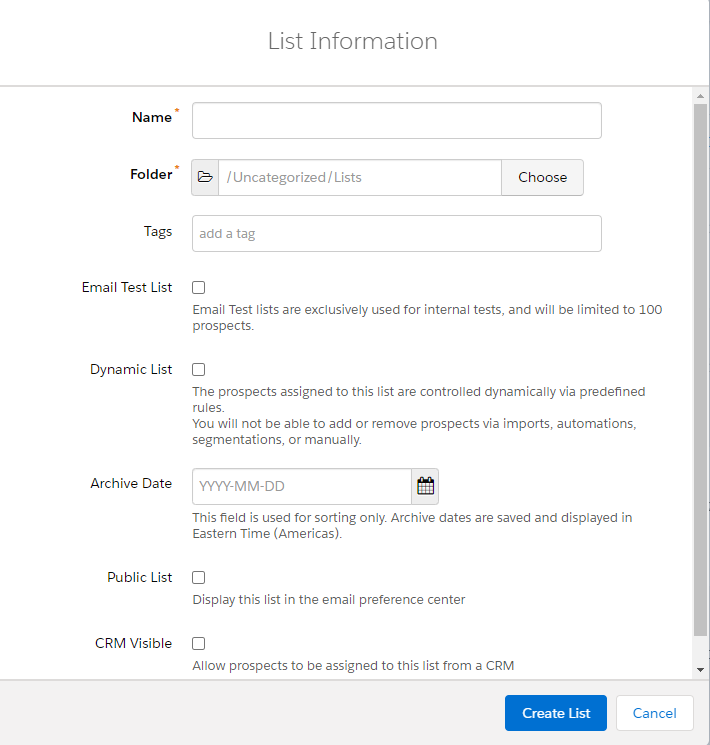Once you have prospects in your Pardot database, you can segment them into prospect lists based on criteria you set. Prospect lists are buckets you can use to group certain prospects together. They are helpful to make sure you’re marketing to the correct group of people.
Segmenting prospects into lists based on unique identifiers is important because it will help you create a personalized marketing message for your audience.
Examples of prospect lists:
- Prospects with job title: CEO
- Prospects on the West Coast
- Prospects that are past customers
As you may know, some prospects have key differences that require them to be in different lists. It’s important to know not only how to classify each list type in Pardot, but also how to use each correctly in your B2B email marketing campaigns.
Download our expert-created guide to begin your journey with Pardot.
Static vs. dynamic lists
There are two main types of prospect lists in Pardot: static and dynamic. There are several vital indicators to differentiate between the two lists. Let’s begin with defining them first, then we’ll go in-depth about each concept and when to use them appropriately.
Static lists: A static list consists of prospects that can be added or removed to the list manually or via automations. Think of this as a bucket you must fill on your own.
Dynamic lists: A dynamic list uses conditioned-based rules that automatically add prospects who match your specified criteria and remove those who don’t. These lists are constantly being refreshed and updated in real time.

Now that you have a high-level overview of each of the list types, let’s break down static and dynamic further.
Static lists
Static lists are a stagnant list that do not ever change, unless you update them manually in your Pardot instance or with an automation rule or completion action. In contrast to dynamic lists, it does not automatically update when a prospect’s data changes.
Examples of static lists include:
- Trade shows
- Event registrants/attendees
- Monthly newsletters
A few use cases for a static list are when you are trying to follow up with information after events or send quarterly emails like a newsletter. So when you build a static list, you can be confident that your emails will reach your prospect with proper segmentation.
Dynamic lists
Dynamic lists are most beneficial when building lists around information that changes frequently. They can be considered as a form of automation – rather than triggering a particular action, dynamic lists automatically add or remove prospects to a working list that cannot be adjusted manually.
You can create these lists based on certain criteria:
- Pardot grade/score
- Default or custom fields
- Lead assignment
- Form submissions
One common example of using a dynamic list is for sending an engagement email based on your prospects’ interests. If a prospect downloads a whitepaper on your site, you may want to add them to an email series that provides them with more relevant content.
Consider dynamic lists to be a powerful component in your marketing automation toolbox. Dynamic lists can segment your database in real-time, so you can create compelling email campaigns based on your prospect’s criteria.
Additional list types in Pardot:
Email test lists
Email test lists are exclusively used for internal tests. This is to ensure your emails are rendering properly across the board before sending it out to your prospects.
Note that email test lists cannot be public or CRM visible lists. Test lists are also limited to 100 people.
A use case for using email test lists is gathering a few people on your sales team to review your email blasts before they go out to your prospects.
Public lists
These lists are available on your email preference center page. It gives your prospect the ability to opt in or out of certain mailing lists — such as newsletters and marketing material.
To create a public list in the email preference center, you will need to have a label and description that explains how the individual enrolled in that email marketing list.
CRM visible
A CRM visible list allows prospects to be assigned to the list from a CRM. This option is only available if you have a verified CRM connector between Pardot and Salesforce.
Suppression lists
Suppression lists are used to stop prospects in your database from getting multiple emails in your list or engagement program emails. They can help protect your sender reputation while maintaining a high email deliverability score.
Conclusion
Now that we have identified how Pardot prospect list types work, particularly in how to apply best practices to each list, we can move on to the lead scoring chapter.


